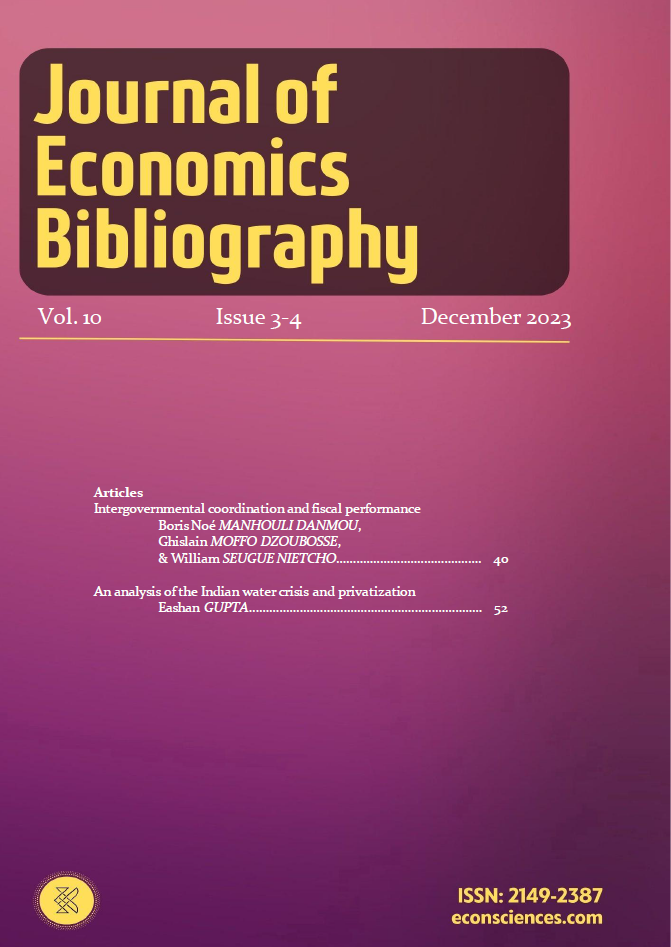Abstract
Abstract. The paper analyzes the India water crisis. Water scarcity in India has been a problem for a number of years now as many Indian water sources contain biological pollutants and excessive use of groundwater for irrigation depletes water reservoirs. This paper will explore non-revenue water levels and conduct a cost benefit analysis. It will conclude with a recommendation on where the solution to mitigating the Indian water crisis lies – privatization.
Keywords. Privatization; Water crisis; India.
JEL. E62; I28; H52; H11.
References
Byatt, I. (2008). A Regulator’s Sign-off: Changing the Taps in Britain. 2019. Charting Our Water Future: Economic Frameworks to Inform Decision-Making. McKinsey and Company, The Water Resources Group.
Byatt, I. (2019). Composite Water Management Index.” NITI Aayog, Aug. [Retrieved from].
Byatt, I. (n.d.). Corruption and Integrity. India Water Portal, [Retrieved from].
Byatt, I. (2006). Delhi Water Supply & Sewerage Project, Project Information Document Concept Stage. World Bank, 15 Mar. 2006. [Retrieved from].
Byatt, I. (2008). Designing an Effective Leakage Reduction and Management Program.” World Bank, Water and Sanitation Program, Apr. [Retrieved from].
Edmond, C. (2019). Cape Town Almost Ran out of Water. Here's How It Averted the Crisis. World Economic Forum, 23 Aug. [Retrieved from].
Edmond, C. (2012). Frequently Asked Questions on Water Integrity - A Primer by the Water Integrity Network. India Water Portal, 9 Oct. [Retrieved from].
Hanke, S.H. (1981). Distribution System Leak Detection and Control.” Water Engineering and Management, 81.
Hanke, S.H. (1987). Privatization. The New Palgrave: Dictionary of Economics, Edited by John Eatwell et al., vol.3.
Hanke, S.H., & Roland, W. (1981). On the Marginal Cost of Wastewater Services. Land Economics, 57(4), 155-184.
Hanke, S.H., & Walters, S. (2011). Privatizing Waterworks: Learning from the French Experience. Journal of Applied Corporate Finance, 23(3), 30–35.
Hanke, S.H., & Walters, S. (2011). Reflections on Private Water Supply: Agency and Equity Issues. Journal of Applied Corporate Finance, 23(3), 36–40.
“IBNet Database.” IBNet, [Retrieved from].
“India - Veolia Water to Supply Another 200,000 People in Karnataka State.” Veolia Water, 6 June 2013, [Retrieved from].
“India.” Transparency International - India, [Retrieved from].
“India's Water Crisis: Causes and Cures.” The National Bureau of Asian Research (NBR), [Retrieved from].
“Introducing 24/7 Water Supply - Challenges in Three Cities in Karnataka, India.” World Bank, [Retrieved from].
Kingdom, Bill, et al. “The Challenge of Reducing Non-Revenue Water (NRW) in Developing Countries - How The Private Sector Can Help: A Look at Performance-Based Service Contracting.” World Bank, 1 July 2010, [Retrieved from].
Matkin, James. “Underpricing Water Is Our March of Folly – India Must Take Cost Recovery Primary or Dire Consequences.” Analysis: The Voice of New Change, I, no. 4, June 2015.
“Report: India's Water conomy, Bracing for a Turbulent Future.” World Bank, [Retrieved from].
Schwartzstein, Peter. “The Merchants of Thirst.” The New York Times, The New York Times, 11 Jan. 2020, [Retrieved from].
Snyder, Shannyn. “Water In Crisis - Spotlight India.” The Water Project, [Retrieved from].
Tnn. “Mumbai: 30-Hour Water Cut Tomorrow.” The Times of India, 12 Sept. 2019, [Retrieved from].
Wyatt, Alan. Non-Revenue Water: Financial Model for Optimal Management in Developing Countries. June 2010, [Retrieved from].

This work is licensed under a Creative Commons Attribution-NonCommercial 4.0 International License.
